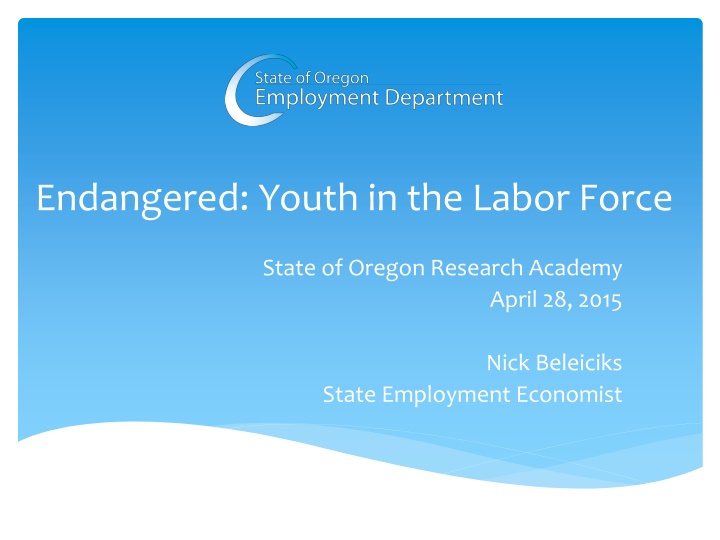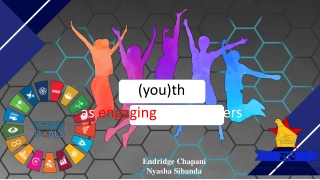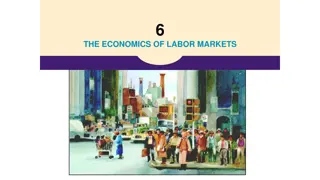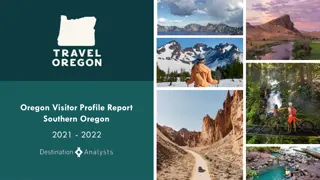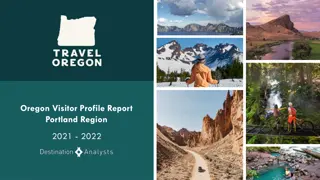Endangered Youth in Labor Force State of Oregon Research Academy
A research study conducted in Oregon reveals concerning trends in youth employment, highlighting the impact of economic changes on job opportunities for individuals aged 14 to 24. The report discusses the decline in youth workers, high unemployment rates, and their disproportionate share of declining labor force participation, shedding light on the challenges faced by younger individuals in the workforce.
Download Presentation

Please find below an Image/Link to download the presentation.
The content on the website is provided AS IS for your information and personal use only. It may not be sold, licensed, or shared on other websites without obtaining consent from the author.If you encounter any issues during the download, it is possible that the publisher has removed the file from their server.
You are allowed to download the files provided on this website for personal or commercial use, subject to the condition that they are used lawfully. All files are the property of their respective owners.
The content on the website is provided AS IS for your information and personal use only. It may not be sold, licensed, or shared on other websites without obtaining consent from the author.
E N D
Presentation Transcript
Endangered: Youth in the Labor Force State of Oregon Research Academy April 28, 2015 Nick Beleiciks State Employment Economist
Jobs in Nursing and Residential Care Facilities by Age Group King County, Washington 25,000 19 Years and Older 14 to 18 Years 20,000 15,000 Number of Jobs 20,723 10,000 15,293 5,000 503 447 0 1993 2013 Source: U.S. Census Bureau, Local Employment Dynamics
Available online at www.QualityInfo.org Search for Youth Report
Executive Summary #1 Oregon added tens of thousands of new jobs while recovering from the Great Recession, but recent job growth completely overlooked younger workers. There were actually fewer workers ages 14 to 21 in 2013 than in 2010.
Executive Summary #2 Unemployment rates for youth increased drastically during the recession and have not returned to previous levels. The unemployment rate of Oregon teens ages 16 to 19 years was 28.0 percent in 2014, while the rate was 12.7 percent among young adults ages 20 to 24 years.
The recession sent youth unemployment rates to record highs and rates remain at troubling high levels. Unemployment Rates High for Oregon's Youth (Years with Recessions Shaded Gray) Young people were just 13 percent of the labor force in 2014, but they accounted for 31 percent of unemployed Oregonians. 35% 16-19 years 20-24 years Age 25 years and over 30% 25% Unemployment Rate 20% 15% Unemployment rates: 16-19 years: 28.0% 10% 5% 20-24 years: 12.7% 0% 25+ years: 5.6% 1978 1981 1984 1987 1990 1993 1996 1999 2002 2005 2008 2011 2014 Source: Bureau of Labor Statistics, Current Population Survey
Executive Summary #3 Young workers account for a disproportionate share of falling labor force participation. Young people ages 16 to 24 accounted for more than one-quarter of the decline in the state s overall labor force participation rate since 2000.
After years of decline, the share of youth participating in the labor force reached the lowest point on record in 2013. Oregon Teen Participation Rate at Historic Lows (Years With Recessions Shaded Gray) It s now far more common for teens to be neither working nor looking for a job. 100% 16-19 years 20-24 years Age 25 years and over 90% 80% Labor Force Participation Rate 70% Participation rates: 60% 50% 16-19 years 36% 40% 30% 20-24 years 72% 20% 10% 25+ years 62% 0% 1978 1981 1984 1987 1990 1993 1996 1999 2002 2005 2008 2011 2014 Source: Bureau of Labor Statistics, Current Population Survey
Executive Summary #4 Youth use fewer job search methods than adults, and they are less likely to use personal networks and public employment agencies in their job search. Increasing the job search methods used by young workers could help them find more employment opportunities.
Job search methods of youth differ from search methods of all workers. Sending out resumes and filling out applications is the most broadly used job search method for all workers. Youth rely on this method more than the average with 62% citing this search method (compared with 57% for all workers). Youth are far less likely to search for jobs using their friends or relatives Youth seldom visit public employment agencies this search method was cited by just 9 percent of job seekers ages 16 to 19, compared with 19 percent of all workers. Just 4 percent of teens use private employment agencies. Source: Bureau of Labor Statistics, Current Population Survey
Snapshot look at job openings currently available for teenagers.
Executive Summary #5 The time young people spend unemployed has lengthened significantly. That is time not spent gaining on-the-job experience. Consequently, the share of unemployed young people with no previous work experience nearly doubled, making it harder for them to compete with experienced applicants.
The share of unemployed teens with no previous work experience is on the rise, and the lack of experience makes it more difficult to find a job. Half of Teen Job Seekers Lack Previous Work Experience Unemployed with No Previous Work Experience, United States Share of unemployed with no previous work experience: 100% Age 16-19 Age 20-24 Age 25 and over Percent of Unemployed in Age Group 75% 16-19 years 54% 20-24 years 16% 50% 25+ years 3% 25% 0% 1994 1996 1998 2000 2002 2004 2006 2008 2010 2012 Source: Bureau of Labor Statistics, Current Population Survey
Executive Summary #6 Postponing work experience harms young workers ability to compete for jobs. Breaking this detrimental cycle could be a focus of public policy efforts. Helping teens find and be successful in their first work experiences could improve their long-term labor market outcomes.
Oregons Local Workforce Investment Boards have developed actionable items to address youth unemployment. Invest funding in summer job programs for youth. Support career readiness and career exploration, targeted to the youth population, throughout the education and workforce system. Provide flexible, evening, and weekend classes within postsecondary institutions to accommodate youth acquiring work-related skills while still focusing on education.
Executive Summary #7 Counter to popular belief, the Great Recession did not increase the share of idle youth those neither in the labor force nor enrolled in school. Roughly 10 percent of youth ages 16 to 24 are considered idle, in Oregon and the U.S.
The number of idle youth has increased over the years, but they remain a relatively small share of the total youth population. Share of Oregon Youth Not Enrolled in School or in the Labor Force 2005 2006 2007 2008 2009 2010 2011 2012 2013 Oregon teenagers ages 16-19 Share "Idle" Oregon young adults ages 20-24 Share "Idle" 180,746 196,959 198,057 198,520 205,933 201,726 201,199 198,801 202,020 5% 5% 6% 5% 5% 5% 6% 5% 5% 246,923 238,695 10% 245,645 10% 244,069 11% 263,883 10% 255,823 10% 263,291 11% 263,393 10% 264,951 11% 9% Source: U.S. Census Bureau, American Community Survey, data for young adults accessed through IPUMS. The use of the word idle here is not intended to be judgmental. Some young people face situations more complex than choosing between work, education, or nothing . Stay at home parents Other family care responsibilities Young people with disabilities
About 1 out of 20 teens could be considered idle. Identifying the Idle Youth: Oregon All People 16 to 19 200,800 100% Enrolled in school 165,600 82% Not enrolled in school 35,200 18% In labor force 25,500 13% Not in labor force 9,700 5% Not in labor force 108,700 54% In labor force 56,900 28% Source: U.S. Census Bureau, 2013 American Community Survey
About 1 out of 9 young adults could be considered idle. Identifying the Idle Youth: Oregon All People 20 to 24 265,000 100% Enrolled in school 105,200 40% Not enrolled in school 159,800 60% In labor force 129,900 49% Not in labor force 29,900 11% Not in labor force 40,000 15% In labor force 65,100 25% Source: U.S. Census Bureau, 2013 American Community Survey, accessed through IPUMS.
Executive Summary #8 The money earned by working teens, especially those from lower income families, helps improve their families finances and stimulates the local economy.
Money Earned by Teens Benefits Families and the Local Economy A 2009 summer youth employment program for low income youth in rural Oregon generated an additional 47 cents in economic impact for every dollar the program spent. The youth dedicated the largest share (26%) of their paychecks to family members or guardians. An additional 20 percent of the youth said they saved their earnings for cars or trucks, housing, college, or future bills. The remaining spending, most of which occurs locally, was on groceries, gas, clothing, electronics, eating out, and sports.
Executive Summary #9 Youth today face increased requirements related to high-school graduation and college preparation, and those enrolled in school are less likely to be in the labor force than in the past. Many are forgoing early work experience to gain formal education, which could pay off long-term given the college wage premium. See note about the college wage premium.
Research shows that teens are substituting education for labor market experience. They are spending more time on academic activities. Oregon High School Graduation Requirements Increased for 2008 9th Graders Students are spending more time to graduate from high school. 2008 9th graders and beyond 24 4 3 (Algebra I and above) 3 3 1 1 3 6 Required credits* to graduate Total English/Language Arts Math Social Science Science Physical Education Health Arts/Career/Tech Ed./Second Language Electives Pre-2008 22 (back to 1970s) 3 2 3 2 1 1 1 9 The new requirements include more stringent math and additional science and English / Language arts. * One credit equals 130 hours seat time; excludes homework Source: Oregon Department of Education
Key Point about Regulations Although youth labor market woes are sometimes blamed on stricter regulations, current state and federal regulations for hiring youth have been in place for decades and predate the start of the downward trend in teen labor force participation.
Working hours limited for 14 and 15 year olds in nonagricultural jobs. When school is in session Not allowed during school hours Only between 7:00 am and 7:00 pm 18 hours per week maximum 3 hours on school days 8 hours on non-school days When school is not in session From June 1 through Labor Day: 7:00 am to 9:00 pm 40 hours per week maximum 8 hours per day 16 and 17 year olds can work any hours, up to 44 hours per week Source: Bureau of Labor and Industries, Employment of Minors
Agricultural work is still allowed for minors Ages 9 to 11 years old may work with parental consent on a small farm which is operated under state regulations Picking berries and beans for intrastate commerce Ages 12 and 13 years old may work with parental consent in agricultural jobs not declared hazardous by the U.S. Secretary of Labor. Ages 14 and 15 do not need parental consent Work by those under the age of 16 must be outside school hours Ages 16 and 17 may work at any time in jobs not declared hazardous. Source: Bureau of Labor and Industries, The Employment of Minors in Agriculture
Employing minors requires extra paperwork from employers. Oregon employers must obtain an annual employment certificate to employ minors under 18 years old. The requirements are simpler now than in 1995 and prior. Individual permits were required by both the minor and the employer for each minor hired. Federal law requires employers of minors in agriculture to maintain records of name, address, date of birth, and written parental consent if required. Source: Bureau of Labor and Industries, Employment of Minors: Questions & Answers
Nick Beleiciks State Employment Economist Nick.J.Beleiciks@oregon.gov 503-947-1267 To find this presentation online, go to www.QualityInfo.org and use the search box to look up my name Join the conversation: OregonEmployment.blogspot.com Twitter @OrEmployment
